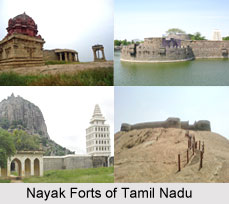 The Nayak rulers were originally the provincial governors or feudatories under the Vijayanagar Emperors. They ruled in Tamil Nadu from the 14th to the 17th centuries A.D. Nayaka dynasties emerged after the downfall of Vijayanagar Empire.
The Nayak rulers were originally the provincial governors or feudatories under the Vijayanagar Emperors. They ruled in Tamil Nadu from the 14th to the 17th centuries A.D. Nayaka dynasties emerged after the downfall of Vijayanagar Empire.
After the decline of the Vijayanagar power, the Nayaks became the independent rulers of the territories. After the Battle of Talikota, several of them declared independence. The most important Nayak dynasties in South India included the Gingee, Vellore, Thanjavur and Madurai in Tamil Nadu. During the Nayaka rule, the kings built many forts to defend themselves from the Muslims and the European powers, the Portuguese, Dutch, French, Danish and English, who began to interfere in the dynastic politics of Tamil Nadu and other parts of South India. Some of the forts are mentioned below:
•Attur Fort: The fort was built by a Palaiyakkarar chieftain under Madurai Nayaks, called Lakshmana Nayaka during the 17th Century in the Salem district. It was also occupied by Hyder Ali, Tipu Sultan and British during various times. The fort was used by the British as a garrison till 1854, after which the fort was not operational.
Dindigul Fort: The Dindigul Fort is a 17th-century hill fort, built by Madurai Nayak situated in the town of Dindigul in the state of Tamil Nadu. The fort was built by the Madurai Nayak King Mutthu Krishnappa Nayak in 1605. In the 18th century the fort passed on to Kingdom of Mysore. In 1799 it went to the control of the British East India Company during the Polygar Wars.
•Vellore Fort: There is a large fort at Vellore, which is made of huge granite blocks and is surrounded by a moat. This 16th century fort was built by Chinna Bommi Nayak. There is a temple named `Jalakanteshvara` can be seen within this fort, which with its exquisite carvings and pavilions of the late Vijayanagar style attracts a lot of people. A small museum can also be found within the fort.
•Gingee Fort: The Gingee fort is much larger than the Vellore fort. It is a hill fort, which encircles three large hills. The fort complex consists of a granary, magazine room, elephant and horse stables, tanks, temples and mosque. During recent years, many artifacts of the Gingee Nayaks were found out from the fort complex by the archaeologists.
•Namakkal Fort: Namakkal Fort is a historic fort present in Namakkal district. The fort is located on the top of a hillock made of a single rock, 75 m tall. As per history, the fort was built by the Madurai Nayaks during the 17th century. The fort is originally believed to have been built by Ramachandra Nayak, the Polygar of Sendamangalam.



















